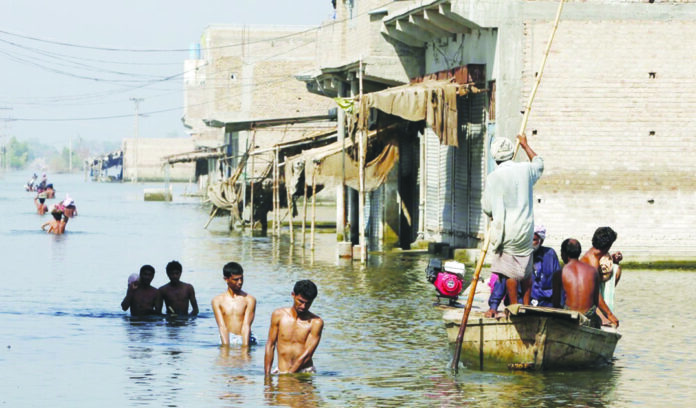The province of Sindh stands at a critical juncture in its development trajectory as it faces the mounting challenges posed by climate change. Situated along the Indus River delta and encompassing diverse ecosystems from arid deserts to fertile agricultural plains and a lengthy coastline, Sindh’s geography makes it particularly vulnerable to the impacts of a warming planet.
The increasing frequency and intensity of extreme weather events – devastating floods, prolonged droughts, and intense heatwaves – are already taking a heavy toll on the province’s economy, infrastructure, and most importantly, its people. These climate impacts threaten to reverse decades of development progress and exacerbate existing socioeconomic inequalities unless urgent, coordinated action is taken. The framework provided by Pakistan’s Nationally Determined Contributions (NDCs) under the Paris Agreement, coupled with emerging opportunities in climate finance, offers a pathway for Sindh to build resilience while pursuing sustainable development. However, translating these global commitments into local action requires overcoming significant technical, financial, and institutional challenges specific to the province’s context.
At the heart of Sindh’s climate vulnerability is its water crisis, which manifests in increasingly complex ways. The province’s dependence on the Indus River system, combined with changing precipitation patterns and rising temperatures, has created a situation where water scarcity and flooding occur in rapid succession. Advanced hydrological modeling using tools like the Water Evaluation and Planning (WEAP) system reveals alarming trends— groundwater recharge rates in northern Sindh have decreased by approximately 30 percent over the past two decades, while evaporation losses from major reservoirs have increased by 12-15 percent due to rising temperatures. These changes have severe implications for agriculture, which remains the backbone of Sindh’s economy, supporting millions of livelihoods. The 2022 floods provided a devastating demonstration of this vulnerability, submerging vast agricultural areas and causing losses estimated at billions of dollars. Compounding these challenges is the creeping threat of sea level rise along Sindh’s coastline, where sophisticated modeling using LIDAR topographical data projects that 1,200-1,500 square kilometers of land could be permanently inundated by 2050 under high-emission scenarios. The saltwater intrusion this brings has already rendered 35 percent of previously arable land in coastal areas unproductive, displacing communities and disrupting traditional livelihoods.
In the energy sector, Sindh possesses remarkable potential to contribute to Pakistan’s NDC targets through renewable energy development. The province’s solar energy capacity could theoretically meet several times Pakistan’s current electricity demand, with photovoltaic potential exceeding 1,800 kWh/m²/year across most districts. Similarly, the Jhimpir wind corridor boasts some of the best wind resources in South Asia, with average speeds of 7-8 m/s and capacity factors approaching 34 percent. However, harnessing this potential requires overcoming significant technical barriers. Grid integration challenges stemming from the variable nature of renewable generation necessitate investments in battery storage systems and smart grid technologies.
The development of agri-voltaic systems, which combine solar power generation with agricultural production, offers a promising solution to optimize land use while providing additional income streams for farmers. Pilot projects in Thar have demonstrated the technical feasibility of this approach, but widespread adoption requires addressing financing barriers and developing local technical capacity for installation and maintenance. Distributed renewable energy systems, particularly solar microgrids, could transform energy access in rural areas, but their long-term sustainability depends on establishing viable business models and local maintenance ecosystems.
Agriculture, which accounts for 28 percent of Sindh’s GDP and employs 43 percent of its workforce, requires fundamental transformation to adapt to changing climate conditions. The increasing frequency of heatwaves and shifting rainfall patterns are already reducing yields of staple crops like wheat and cotton. Precision agriculture technologies, including soil moisture sensors and automated irrigation systems, have shown potential to improve water use efficiency by 30-40 percent in pilot projects. However, their broader adoption faces challenges related to cost, farmer awareness, and the need for localized calibration to Sindh’s specific soil and water conditions.
Crop modeling tools such as the Decision Support System for Agrotechnology Transfer (DSSAT) can help farmers anticipate climate impacts and adjust planting schedules, but require extension services to translate scientific insights into practical guidance. In coastal areas, where salinity intrusion has devastated agricultural lands, innovative approaches like biosaline agriculture- using salt-tolerant crop varieties- and electrochemical desalination are being tested, but need substantial scaling up through public-private partnerships. These technical solutions must be complemented by institutional reforms in water governance and agricultural extension services to ensure their effective implementation.
Long-term planning (beyond 2030) must envision transformative shifts toward climate-resilient development across all sectors. Throughout this process, regular monitoring and evaluation using scientifically robust indicators will be essential to track progress, learn from setbacks, and adapt strategies as needed.
Coastal resilience presents another critical challenge for Sindh, where sea level rise and intensifying cyclones threaten both ecosystems and human settlements. The Indus Delta’s mangrove forests, which once spanned over 600,000 hectares, have shrunk by 72 percent since the 1950s due to reduced freshwater flows and sea level rise. These mangroves provide invaluable ecosystem services, acting as natural buffers against storm surges while sequestering significant amounts of carbon.
Restoration efforts have rehabilitated approximately 160,000 hectares, but maintaining and expanding these gains requires ongoing scientific monitoring using satellite imagery and drone-based surveys. Hybrid approaches combining natural solutions like mangrove restoration with engineered structures such as permeable seawalls may offer the most sustainable path forward. However, these interventions must be carefully designed to accommodate the needs of local communities, particularly fisherfolk whose livelihoods depend on healthy coastal ecosystems. The technical complexity of these solutions underscores the need for interdisciplinary collaboration between hydrologists, ecologists, engineers, and social scientists.
Climate finance represents the critical link between Sindh’s climate challenges and their solutions. Accessing international climate funds like the Green Climate Fund (GCF) requires sophisticated project preparation capabilities, including detailed feasibility studies, financial modeling, and robust monitoring frameworks. Sindh’s recent $50 million GCF proposal for climate-resilient water infrastructure exemplifies the level of technical rigor required, incorporating hydraulic modeling using EPANET software and climate-adjusted design standards that exceed historical extremes by 25 percent.
Smaller-scale projects may find better alignment with the Adaptation Fund’s grant programs, which can support community-led initiatives like rainwater harvesting systems or heat-resistant housing designs. Mobilizing private sector investment through instruments like green bonds or climate insurance products presents another avenue, but requires developing enabling policy frameworks and building investor confidence. The emerging field of nature-based solutions finance, including blue carbon credits from mangrove conservation, could provide additional revenue streams for coastal protection efforts, but depends on establishing credible measurement and verification systems.
The successful implementation of climate actions in Sindh hinges on addressing fundamental capacity gaps at institutional and technical levels. The province lacks a centralized repository for climate data, forcing planners to rely on fragmented or outdated information. Establishing a Sindh Climate Data Hub with open-access modeling tools and real-time monitoring systems would provide a foundation for evidence-based decision making. Similarly, the absence of specialized training programmes in areas like greenhouse gas inventory compilation, renewable energy system design, and climate risk assessment creates bottlenecks in project implementation. Investing in climate education and technical vocational training could help build a pipeline of skilled professionals to support the province’s transition. Institutional coordination remains another critical challenge, as climate-related responsibilities are currently scattered across multiple departments with limited mechanisms for collaboration. Creating a dedicated Provincial Climate Authority with cross-sectoral mandate could help bridge these divides and ensure climate considerations are mainstreamed into all development planning.
The human dimension of Sindh’s climate challenge cannot be overlooked in technical discussions. Behind every statistic about crop losses or coastal erosion are real people facing disruption to their lives and livelihoods. Traditional knowledge systems, particularly those of indigenous communities in the delta and desert regions, hold valuable insights for adaptation that should be integrated with scientific approaches. Community-based monitoring networks could complement technical systems by providing ground-level data while building local ownership of climate actions. The psychological toll of climate impacts, evident in rising rates of depression and anxiety among farming communities facing repeated crop failures, underscores the need for mental health support to be incorporated into adaptation programmes.
Looking ahead, Sindh’s climate action priorities must be guided by both urgency and pragmatism. Immediate-term measures should focus on establishing foundational systems like the Climate Data Hub while scaling up proven solutions through targeted pilot projects. Medium-term goals (2027-2030) should aim for systemic changes, such as mainstreaming climate criteria into all infrastructure approvals and achieving significant renewable energy penetration.
Long-term planning (beyond 2030) must envision transformative shifts toward climate-resilient development across all sectors. Throughout this process, regular monitoring and evaluation using scientifically robust indicators will be essential to track progress, learn from setbacks, and adapt strategies as needed.






















